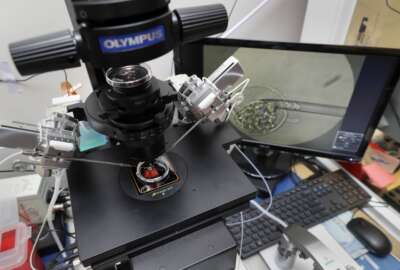Digital transformation – the term has become a kind of shorthand for federal agency activities aimed reaching the next generation of information technology. Transformation requires reworking of everything from data centers to applications. A frequent goal digital transformation is customer service to citizens and constituent industries on par with the best of commercial online service.
The default thinking on digital transformation envisions improved online transactions. But many agencies are also at work on improving transactions that must and always will take place in person. “Transaction” in this context means a broad range of interactions; for example, verifying identities of people boarding airliners; admitting or readmitting people into U.S. border checkpoints or federal buildings; identifying friend-or-foe at long distances in military situations.
Biometric attributes, and facial recognition in particular, have seen growing importance both in multifactor authentication and in removing what might be called friction in transactions occurring in the physical world.
Here’s how Benji Hutchinson, the vice president of federal operations for NEC Corporation of America’s Advanced Recognition Systems Division, put it: “When we talk about digital transformation, or DX, it often has to do with the physical and the digital world colliding, or coming together and knocking down barriers. When we talk about digital transformation, we mean deploying the technologies that create a new paradigm, or a new way of doing business, whether that’s through enhancing the customer experience, or evolving the business processes that are currently in place.”
At the same time, biometrics technologies have come along quite a bit just in the last couple of years. The application of artificial intelligence to algorithmic processing is one factor that’s helped. Another is having an objective frame of reference for testing, verifying, and promulgating biometric technologies maintained by the National Institute of Standards and Technologies.
The major vendors, like NEC, have been able to eliminate many of the shortfalls in accurate recognition across a wide variety of demographics, Hutchinson said.
In response to the pandemic that’s caused millions of people going about with the lower half of their faces covered, NEC “with artificial intelligence, machine learning, and deep learning, we’ve been able to modify and upgrade the algorithms to correct for the face coverings. It’s pretty miraculous. We can look at different vectors and attributes on the face and compensate for that face covering,” he said.
These and other advances have enabled a wide range of federal use cases for digital transformation of processes and services, Hutchinson said.
A signature project is at Customs and Border Protection, which has been rolling out instances of facial recognition to speed people through at locations throughout the country. The latest instance is the Peace Bridge connecting the U.S. and Canada at Niagara Falls, where pedestrians who agree to privacy-protected facial recognition now have a nearly frictionless passage back and forth.
NEC technology “enabled this touchless, contactless, hygienic verification process,” Hutchinson said. “No longer do international travelers need to take out their passport to verify identity with customs officials.” In an example of how federal and private sector technologies sometimes intersect, Hutchinson said airlines are starting to explore similar products in “curb to gate” or even airport toll plaza-to-gate solutions. The goal is a seamless, digital check-in for the carrier consistent with ID verification for the Transportation Security Administration.
A further transportation development is the integration of remote temperature sensing with facial recognition. It lets screeners check both identity and the presence of fever that could indicate covid or some other contagious condition. Hutchinson said the Hawaii Department of Transportation has deployed this technology at the five major airports in the state.
The Defense Department is also looking at how facial can enhance physical access processes, which often entail long vehicle lines at major installations.
“How do we grab a face through a windshield and enable smoother entry and exit from a base through hot lanes, for example? Can we grab that facial recognition through the windshield of people who have opted in and enable the smooth flow of traffic?” Hutchinson said.
For future, Hutchinson said, look out for even more-capable algorithms that train more easily, and improve computer vision facial and other domains. Object recognition, for example, is becoming more sophisticated, as is video analysis.
So it can work more deeply with federal agencies, Hutchinson said, NEC this year will launch a fully U.S.-based company “focused exclusively on the U.S. federal government and artificial intelligence, computer vision, biometrics, and also next generation communications like 5G, and also fiber optic sensing technology.”
He added, “We wanted to mitigate our foreign ownership issues, and put up that firewall to give that level of security and assurance to the federal government that we are a trusted partner.”
In-Person Digital Transformation
When we talk about digital transformation, we mean deploying the digital technologies that create a new paradigm, or a new way of doing business, whether that's through enhancing the customer experience, or evolving the business processes that are currently in place.
Benji Hutchinson
Vice President, Federal Operations Advanced Recognition Systems Division, NEC Corporation of America
The Department of Defense [is] looking at physical access applications. How do we grab a face through a windshield, and enable smoother entry and exit from a base through hot lanes … and enable the smooth flow of traffic?
Benji Hutchinson
Vice President, Federal Operations Advanced Recognition Systems Division, NEC Corporation of America
Digital Transformation in the Corporate World
Where we really see innovation is video analytics, and being able to process in an automated fashion, all of that data that's coming off of different video streams.
Benji Hutchinson
Vice President, Federal Operations Advanced Recognition Systems Division, NEC Corporation of America
Listen to the full show:
Copyright
© 2024 Federal News Network. All rights reserved. This website is not intended for users located within the European Economic Area.








